

 The South African
The South African
by Hamish Paterson
South African National Museum of Military History
The 1906 Natal Rebellion, or Bhambatha's Rebellion, has been dealt with previously in the Military History Journal by Ken Gillings ('The Bambata Rebellion of 1906: Nkandla operations and the Battle of Mome Gorge' in Volume 8 No 1, June 1989; and, more recently, 'The "death" of Bhambatha Zondi: A recent discovery' in Volume 12 No 4, December 2002). Without replicating what has already been done, this new article seeks to unravel some of the problems experienced with a non-military approach to the subject of the broader history of the Rebellion, which has largely determined the way in which the event is remembered today, a hundred years later.
On 8 February 1906 a Natal Police detachment was attacked after they had arrested three men for participating in an armed gathering. That gathering was a protest against a poll tax which had been imposed on all adult males in the Colony of Natal. Only indentured labourers and those who paid hut tax were exempted. This attack marked the beginning of what is popularly known as the Bhambatha Rebellion. The rebellion has also been called the Natal or Zulu Rebellion. Of these terms, Zulu Rebellion is probably the least appropriate. The bulk of the rebels were not amaZulu and, in fact, were descendants of clansmen who had fled during the formation and expansion of the Zulu Kingdom.
The significance of an historical event lies in its results. Ironically for an event which has been almost forgotten, the Natal Rebellion was momentous in its consequences. It led directly to the formation of the Union of South Africa and the African National Congress. Yet, until recently, it has been largely ignored. At the time, however, two histories were written about it -W Bosman's The Natal Rebellion of 1906 and J Stuart's A History of the Zulu Rebellion. Bosman's account was written shortly after the close of the active phase of the rebellion. Stuart's account has often been accepted as an official or semi-official history. (This is most probably based on the fact that the history is dedicated to Sir Henry McCallum who was Governor of Natal at the time of the rebellion). After this initial interest, not including regimental histories, the rebellion was forgotten until the mid-1960s when mention of it resurfaced in Brookes and Webb's A History of Natal. This was followed in 1970 by the publication of Shula Marks's Reluctant Rebellion.
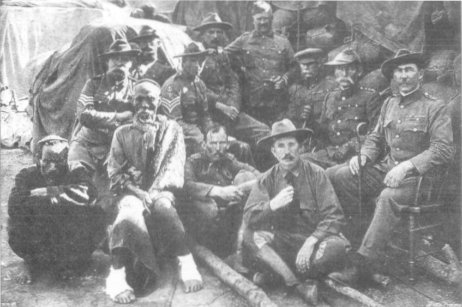
Captured rebel leader, Chief Sigananda, with a Natal Carbineers escort
(The Star Weekly Edition, Johannesburg, 1906)
The need for a military perspective
If there is one major element of continuity from the liberal historian to the radical, to the present-day, as we commemorate the centenary of those dramatic times, it is that all these doctrines manifest a covert paternalism, or to use the late twentieth century term, they are nannyist in character. This has led them to become what W Schivelbusch (2003, pp 1-4) has observed as a 'disinterested' third party who acts on behalf of a defeated group. In some cases, this is the result of a unilateral decision taken by these historians, without consultation with the group they claimed to represent. This 'distance' is the principal problem with studies of the Natal Rebellion.
Another weakness that recurs in studies of this conflict is ignorance of its significant, military context. The post-Second World War period saw the marginalisation of military history as it was perceived to be a manifestation of militarism. The wider implications of military evidence would thus be overlooked. As a result, the Natal Police historian's view of Mome Gorge, as a massacre, was used by Brookes and Webb and Marks overlooked the fact that a part-time military force, the Natal Militia, was not the best instrument for repression and labour extraction, a peculiar omission in view of the broader economic implications of the long term mobilisation of a military force. The Natal Rebellion does not even have an index reference in Volume VII of the abridged edition of the UNESCO General History of Africa.
(Marks's Reluctant Rebellion is listed in the bibliography, but that is all). To redress this imbalance, this article will look at the neglected military aspects of the Natal Rebellion.
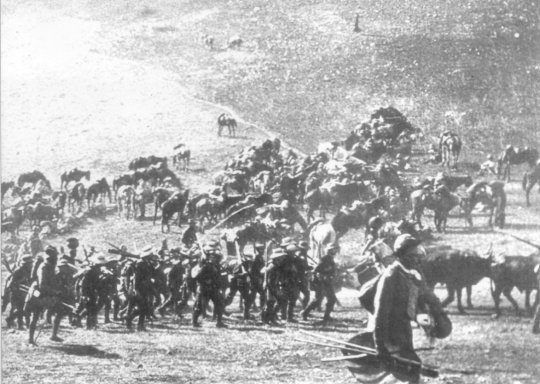
Detail from a photograph showing members of the Natal Naval Corps
(wearing broad white hats) leading a group into the Nkandla area, 1906 (Photo: SANMMH)
Rebels' lack of success
Unlike the other examples of resistance dealt with in the UNESCO General History of Africa, Volume VII, what stands out in the Natal Rebellion is the consistent lack of success of the rebels from the beginning. The initial encounter at Trewirgie (8 February 1906) resulted in the deaths of two policemen. The Mpanza ambush (4 April) cost the Natal Police four dead. Thereafter, the Natal forces lost four killed at Mpukunyoni (28 May) and five killed at Manziphambana (3 June). By contrast, the rebels suffered terribly, their total losses being estimated in the region of 2 300. At the time, this disparity in casualty figures led to criticism by those far from the scene of the conflict (Bosman, 1907, p v). Similar inequality in losses occurred at the battle of Omdurman, but, unlike that battle, none of the actions of the Natal Rebellion were fought in open terrain. Instead, much of the fighting took place over broken ground which, to a certain extent, reduced the firepower advantage ofthe Natal Militia, although the rebels were unable to exploit this.
Respect for the opponent
Historians have also tended to ignore the important implications of the fact that the Natal commanders did not underestimate the strengths of the rebels. A crucial factor in the handling of the Rebellion is that the rebels were treated as serious opponents. This was probably a legacy of earlier conflicts in the region and is evident by the success of their operations in terrain more broken than that which had brought disaster to Potgieter and Uys at Italeni in 1838 and to the mounted troops of Wood's column at Hlobane in 1879.
This respect for the rebels as opponents is certainly the most underrated military aspect of the war. Without it, the Natal forces may have experienced a major disaster meriting the rebellion's inclusion in UNESCO's General History. In practical terms, it meant that the Natal forces were able to anticipate rebel moves and were prudent in areas which offered possibilities of ambush. There is a tendency to underestimate the actual number of rebel losses, possibly in order to belittle the effectiveness ofthe Natal Militia, but, by extension, also belittling the rebels themselves. The rebels came from a warrior culture and to imply that they gave up after suffering minimal losses is to question their prowess as warriors.
Manziphambana
The absence of any major rebel success in 1906 meant that, in general, rebel morale declined. Manziphambana, where Royston's Horse held out until rescued, with the loss of four killed in action, one died of wounds, and ten wounded, was an exception. This rebel 'success' was an expensive one - rebel losses for the day were estimated at 140. Rebel morale was boosted after this action, but this was the result of misinformation. In tribal warfare terms, the number of men lost on that day to the rebel side should be seen as catastrophic. No clan could afford to take losses of that magnitude on a daily or even weekly basis over a period of months. As Lawrence Keeley observed in War before Civilization (1996, pp 63-5; 92-3), apparently small percentage losses spread over a period of time could be more catastrophic than a large face-to-face encounter such as Gettysburg. For a clan or a tribe, replacements would only become available when potential warriors reached manhood. In view of this, the loss of an unmarried warrior was a particularly devastating event. The Natal Militia, on the other hand, could absorb the Manziphambana losses more easily because they were suffered by an irregular war service unit which drew its recruits from a large pool of adventurous or unemployed men within the British Empire. In theory at least, these men could be replaced.
The Manziphambana action must also be viewed in relation to the issue of taking prisoners. During the Rebellion, a large number of rebels were taken prisoner by the Natal forces. In contrast, the Nguni warrior code did not seem to include a mechanism for taking prisoners. Manziphambana shows that the trapped Royston's Horse detachment understood that surrender was not an option. In similar circumstances in the Anglo-Boer War, the detachment may well have surrendered. The different cultural approaches to conflict and the absence of an agreed to set of rules of conflict are important aspects often overlooked by historians, which can lead to a misinterpretation of military realities, especially on a moral front.
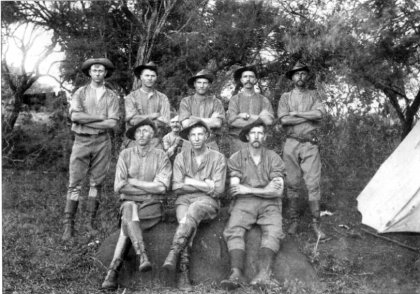
Bhambatha Rebellion 1906. A group of men from the Umvoti Mounted Rifles
(Photo: SANMMH)
Mobilisation of the Natal forces
An important issue which leads on from the existence of irregular units such as Royston's Horse and the Natal Rangers is the implicit claim that the Natal Colonial Government calculated that units such as these could be raised with ease (Marks, 1970, p 184). Where is the evidence of the necessary preparations being made? The formation of Royston's Horse and the Natal Rangers was a symptom of something more fundamental. Like Great Britain during much her history, the Colony of Natal was reluctant to undertake military expenditure. Indeed, the economic crisis which led to imposition of the poll tax, had also led to a process of reduction in the strength of the Natal Militia. In addition to this, the implementation of the formation of the Reserves, envisaged by the 1903 Militia Act, had been placed on hold. Royston's Horse was formed because the Militia Reserves were not ready and used resources that should have been used to equip these Reserves. The Natal Government could also not have known, with any certainty, that aid would be forthcoming from the Cape and the Transvaal in the event of a crisis.
The role of the ordinary soldier
Although, in retrospect, the Natal Militia conducted a competent campaign against the rebels, it was in the interests of those promoting Union to play down that competence and emphasise the need for outside help. The sheer difficulty of operating in the Nkandla forests and bringing the rebels to battle certainly raised the issue of the staying power of the Natal Militia, but the ambush at Mome Gorge proved the Natal Militia to be a military force with which to be reckoned. Yet, one of the most marginalised groups in history is the ordinary soldier. Often reviled, sometimes the object of hypocritical concern, and almost always underpaid, it is ironic that the ordinary soldier has been the punch bag of many concerned with the fate of the under-represented. In the case of the disparity evident in the Natal Rebellion, the potential for the misrepresentation of the Natal Militia is considerable.
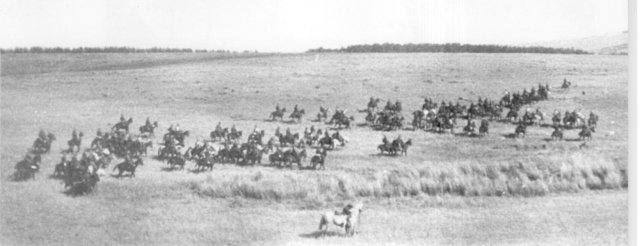
The Transvaal Mounted Rifles on open terrain (Photo: SANMMH)
Isijula versus Firepower
The technological imbalance between the Natal rebels and the Government forces was considerable. According to TN Dupuy (1982, P 313), the theoretical lethality index (TLI) of a javelin (equivalent to the Natal clansman's isijula) is 19. In comparison, the TLI of the Model 1903 Springfield Rifle is 495. The Magazine Lee-Enfield Mk 1* was an even more effective military rifle than the Mauser-clone Springfield. The Maxim and Colt machine-guns used by the Natal forces were of the same order of effectiveness as First World War machine-guns with a TLI of 3 463. In addition to these, the Natal Militia had 15-pr field guns and Pom-Poms and also received 27 Rexer light machine-guns, which were used to devastating effect in the open country of the Mapumulo District.
Firepower was not the sole contributor to the disparity in casualty figures mentioned above, however. Despite their obvious advantage in firepower, the Natal Militia paid their rebel opponents a deadly compliment by treating them as a serious and dangerous enemy. Why? To the reader accustomed to European arrogance, the prudence of the Natal commanders comes as a real surprise. The use of artillery and machine-guns to deliver prophylactic fire on possible rebel ambush spots precedes similar activities by Second World War tank crews by over a generation. These precautions, together with more than diligent scouting, placed the rebels at a considerable disadvantage. Carelessness, which gave the rebellion its initial impetus, especially during the ambush at Mpanza, was absent during later operations. (Risks were, of course, taken in the reconnaissance from Fort Yolland to on 5 May 1906, an operation for which Stuart levels criticism at LtColonel G Mansel, who had clearly not learnt from his experience at Mpanza).
Bobe
The action at Bobe showed poor command on both sides. A lack of coordination between the two groups of rebels involved in this action,led to heavy casualties amongst the first group. The second group had been under the personal command of Bhambatha himself and its failure to come to the aid of the first, and especially the recriminations of the women whose men had been killed in the action, caused Bhambatha to return to the Nkandla forests. The Bobe experience also disproved, on a large scale, Bhambatha's claim that his powers would prevent modern bullets from harming the rebels.
The opposing commanders on both sides showed a lack of tactical skill and it was left to the ordinary rebel warrior and Natal Militiaman to make the difference. Their superior firepower, the fact that the Natal Militia scouts were marginally better than the rebel ambushers, and the actions of the highly skilled Nongqayi gave the Natal Militia the edge. The ambush failed and the rebels paid the price of their lack of firepower.
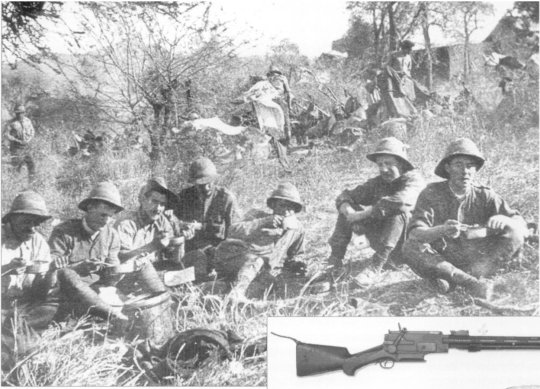
A group of men from the Transvaal Mounted Rifles
at rest during a lunch break in the Nkandla Forest
(Photo: SANMMH)
Mpukunyoni
The next encounter was the result of a calculated risk. The Umvoti Field Force under Colonel G Leuchars had been burning rebel kraals in Mpukunyoni area. On 27 May 1906, the field force met up with Sibindi's levy. It was necessary to select a site for the night's bivouac. The countryside was broken with dongas and covered in bush. The spot selected by Leuchars was an old mealie garden between two dongas, about 200m from a stream and surrounded by bush-covered country with long tam bookie grass-ideal terrain for a stalking Zulu force. The sentries and pickets were ordered to be on the alert. Then, at first light, a patrol was sent out to locate the rebel force which had been spotted the previous evening.
The rebels were found preparing to attack the Umvoti Field Force. They made skilful use of the ground and, in the initial attack, attempted to stampede cattle into the Militia position. A volley killed the cattle and some of the men driving them. The rebels then tried to rush the Umvoti Field Force, but there was sufficient open ground for the Militia rifle fire to prevent the rebels from closing in. As it got light, a new threat emerged. Three snipers, positioned on the ridge to the north, began to pick out targets and caused all the Umvoti Field Forces' casualties in the action four killed or died of wounds, 24 wounded. This sniper fire was countered by rifle fire which carefully searched the cover on the ridge, killing one of the three snipers. The rebel attack began at 06.15 and, by 07.30, was losing momentum. At this point, the Umvoti Field Force, spearheaded by Sibindi's men, counter-attacked. The rebels broke and ran. About 12% of the rebel force of 800 was killed. The distance between the dongas and the Field Force position meant that there was more than enough time for the accurate rifle fire of the Natal Militia to become effective.

Unequal arms of the Rebellion. The clansman's spear
was no match for the Rexer light machine-gun
which added to the firepower of the Natal Militia
(Photo: SANMMH)
The forest drives and Mome Gorge
The next phase of the rebellion involved drives through the Nkandla forests, the imbalance between the relative effectiveness of the Lee-Enfield Mk1* over the isijula continuing to increase the number of rebel casualties. The daily toll of the forest drives was as heavy as the stand-up fight at Mpukunyoni. If the rebels were suffering losses on this scale during the forest drives with their short location ranges and a measure of the initiative shown at Manziphambana, then the heavy losses suffered during the ambush at Mome Gorge and in the open country of the Mapumulo district should come as no surprise. The ambush and the fact that the rebels were clustered together prior to moving would have intensified the potency of the already highly effective weapons of the Natal Militia.
That Mome Gorge was an ambush has received too little consideration by historians. It needs to be understood within the context of other ambushes. For example, at Msebe on 30 March 1883, Zibhebhu's Mandlakazi ambushed an uSuthu force, losing ten and killing over a thousand uSuthu. At oNdini, on 21 July 1883, the Mandlakazi surprise attack at dawn inflicted over 500 uSuthu deaths, with the loss of only seven. The Natal Militia's three dead to about 500 rebel dead at Mome Gorge is thus not atypical of the springing of an effective ambush (J Laband, 2001, pp 46-58; J Stuart, 1913, p 313).
Mapumulo
The open country of the Mapumulo district with its long location ranges had a similar effect, boosted by the arrival of the 27 Rexer (Madsen) light machine-guns which further enhanced the firepower of the Natal Militia. The prudent practices developed by the Natal Militia in the Nkandla forests were continued in the Mapumulo district with the result that rebel losses were again comparatively heavy. The commanders of the Natal Militia understood the Nguni way of war. Leuchars tempted the rebel commanders to do what Zibhebhu had done successfully at oNdini. This time, the tactic failed because it was precisely what Leuchars had wanted. He was prepared for it, with alert sentries, a predawn scout, and firepower. In effect, therefore, McKenzie and Leuchars used the Nguni art of war against the rebels at Mapumulo, just as McKenzie had used the lessons of both Msebe and oNdini in Mome Gorge (C de B Webb and J B Wright, 2001,174-9). A final thought
Social, political and economic historians often pay little heed to military history and the military aspects of an historic event, while they demand, from the military historian, a level of competence in analysing the social, political and economic forces that occur within the realm of military history. The difference between the casualty rates of the Natal Militia and the rebels in the Natal Rebellion provides fertile ground for a politically correct interpretation that may reveal more about the interpreter's own historical baggage than the military technological imbalance of 1906. That the Natal Rebellion had a significant military component cannot be denied and the evidence relating to that deserves to be treated with same care as the rebellion's political, social, economic and environmental components.
'It is an approved maxim in war never to do what the enemy wishes you to do for this reason alone that he desires it.'
Napoleon
(Quoted by Brig Gen J J Collyer, CB, CMG, D80, in The Campaign in German South West Africa, 1914-1915, Pretoria, 1937, p 25)
References
The analysis of the military actions of the Natal Rebellion are based on the descriptions in J S Stuart's A History of the Zulu Rebellion. This is still the most reliable account of the military events of the rebellion.
Adu Boahen, A, General History of Africa (Abridged Edition) Volume VII, Africa under Colonial Domination 1880-1935(UNESCO, Paris, 1990).
Bosman, W, The Natal Rebellion of 1906 (Longman Green and Co, London, 1907).
Brookes, E H, and Webb, C de B, A History of Natal (University of Natal Press, Pietermaritzburg, 1965).
Dupuy, T N, The Evolution of Weapons and Warfare (Jane's, London, 1982).
Keeley, L H, War Before Civilization, The Myth of the Peaceful Savage (Oxford University Press, Oxford, 1996).
Laband, J, The Atlas of the Later Zulu Wars 1883-1888 (University of Natal Press, Pietermaritzburg, 2001).
Marks, S, Reluctant Rebellion: The 1906-1908 Disturbances in Natal (The Clarendon Press, Oxford, 1970).
Miller, C, Battle for the Bundu, The First World War in East Africa (MacDonald and Janes, London, 1974).
Schivelbusch, W, The Culture of Defeat, On National Trauma, Mourning, and Recovery (Granta Books, London, 2003).
Stuart, J, A History of the Zulu Rebellion (Macmillan, London, 1913).
Webb, C de B, and Wright, J B (eds), The James Stuart Archive, Volume 5 (University of Natal Press, Pietermaritzburg, 2001 ).
Return to Journal Index OR Society's Home page
South African Military History Society / scribe@samilitaryhistory.org